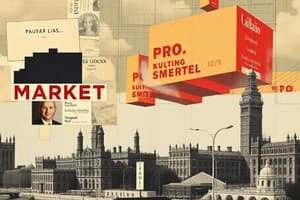Podcast
Questions and Answers
What are the characteristics of an oligopoly?
What are the characteristics of an oligopoly?
- Few large firms, 2) Homogeneous or differentiated, 3) Control over price but mutual interdependence, 4) Entry barriers.
How many firms are in an oligopoly?
How many firms are in an oligopoly?
Usually 3-5.
What are the two types of goods oligopolies produce?
What are the two types of goods oligopolies produce?
- Industrial products
- Consumer goods industries
- Both A and B (correct)
- None of the above
Are oligopolies price makers or price takers?
Are oligopolies price makers or price takers?
What is mutual interdependence in oligopolies?
What is mutual interdependence in oligopolies?
What are the four barriers to entry of an oligopoly?
What are the four barriers to entry of an oligopoly?
Some oligopolies develop from the growth of what?
Some oligopolies develop from the growth of what?
What is a merger?
What is a merger?
What is the concentration ratio?
What is the concentration ratio?
What is the common ratio in oligopolies?
What is the common ratio in oligopolies?
What does it mean if the largest four firms control 40% or more of the market?
What does it mean if the largest four firms control 40% or more of the market?
What are the three shortcomings of concentration ratios?
What are the three shortcomings of concentration ratios?
Define localized market shortcomings of concentration ratios.
Define localized market shortcomings of concentration ratios.
What does definition of industries arbitrary mean?
What does definition of industries arbitrary mean?
What does global trade imply regarding concentration ratios?
What does global trade imply regarding concentration ratios?
What does the oligopoly demand curve look like?
What does the oligopoly demand curve look like?
What is collusion?
What is collusion?
What happens between the firms that collude?
What happens between the firms that collude?
What are the types of joint-profit maximization (collusion)?
What are the types of joint-profit maximization (collusion)?
What is overt collusion?
What is overt collusion?
What is covert collusion?
What is covert collusion?
What is price leadership in an oligopoly?
What is price leadership in an oligopoly?
What are obstacles to collusion?
What are obstacles to collusion?
How does demand affect collusion?
How does demand affect collusion?
How does the number of firms affect collusion?
How does the number of firms affect collusion?
How does cheating affect collusion?
How does cheating affect collusion?
Flashcards are hidden until you start studying
Study Notes
Characteristics of Oligopoly
- Comprises few large firms controlling a significant market share.
- Produces either homogeneous or differentiated products.
- Firms exhibit control over price while maintaining mutual interdependence.
- High barriers to entry prevent new competitors from entering the market.
Number of Firms
- Typically consists of 3 to 5 firms, though the exact number can be undefined.
Types of Goods in Oligopolies
- Industrial products include standardized goods like steel, zinc, and copper.
- Consumer goods may involve differentiated products such as automobiles, electronics, and cereals.
Price Dynamics
- Oligopolies are price makers but must consider competitors’ responses to any price changes.
Mutual Interdependence
- Firms engage in strategic advertising behavior due to their mutual dependence on each other’s actions.
Barriers to Entry
- Economies of scale and high capital requirements.
- Ownership stakes in essential raw materials.
- Patents that protect product development.
- Preemptive pricing and advertising strategies to deter entrants.
Growth from Dominant Firms
- Oligopolies can develop following the expansion of dominant firms in specific markets, such as cereals or candy bars.
Mergers
- Merger definition includes the unification of two or more firms to boost market share and achieve economies of scale, often aimed at enhancing monopoly power.
Concentration Ratio
- Represents the percentage of total output produced by the largest firms in an industry, illustrating market concentration.
Common Concentration Ratio
- The standard focus is on the four-firm concentration ratio.
Interpretation of Concentration Ratios
- A concentration ratio over 40% by the largest four firms indicates significant market control.
Shortcomings of Concentration Ratios
- Localized markets may not accurately represent competition.
- Inter-industry competition can obscure real market dynamics.
- Global trade competition is often excluded from domestic ratios.
Localized Market Limitations
- Concentration ratios reflect national data, potentially ignoring localized market dynamics, such as concrete production.
Arbitrary Industry Classifications
- Industries may overlap, with products from different sectors competing, such as aluminum and copper.
Global Trade Context
- Ratios often fail to account for competition posed by international suppliers in a global market.
Oligopoly Demand Curve
- Characterized as downward sloping, influenced by rivals' reactions to price changes.
Collusion Definition
- Occurs when firms agree to fix prices, divide market shares, or limit competition to enhance profitability.
Collusion Agreements
- Firms that collude often allocate market shares among themselves.
Joint-Profit Maximization Types
- Includes overt collusion (cartel), covert collusion (tacit agreements), and price leadership.
Overt Collusion
- Involves a formal agreement among producers to set prices, control output, and partition the market.
Covert Collusion
- Based on tacit understandings, such as Gentleman's Agreements, lacking formal contracts.
Price Leadership
- A strategy where the dominant firm sets price changes that other firms follow suit.
Obstacles to Collusion
- Demand and cost differences across firms.
- Increased number of firms complicating unity.
- Risks of cheating undermining agreements.
- Economic downturns affecting industry stability.
- Potential new entrants challenging established firms.
- Legal restrictions imposing regulations on collusion.
Demand Influence on Collusion
- Unequal demand curves among firms can lead to divergent production costs, affecting price stability.
Number of Firms and Collusion
- A higher number of firms makes coordinated efforts more difficult, increasing challenges in maintaining collusion.
Impact of Cheating on Collusion
- Any instance of cheating erodes the credibility of the collusion, undermining its effectiveness.
Studying That Suits You
Use AI to generate personalized quizzes and flashcards to suit your learning preferences.





